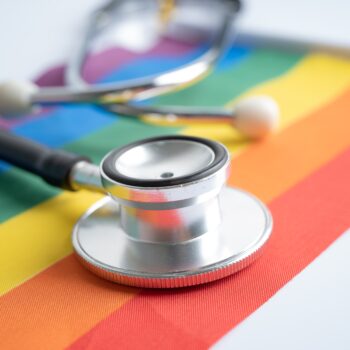This article examines the communication impact of Covid-19 on the Deaf population and how we can support deaf family, friends, and colleagues with the communication challenges caused.
Hearing loss is the second largest disability [1]. Yet the Deaf community began the Covid-19 crisis with little access to public broadcasts due to the lack of translation to British Sign Language (BSL), a visual language and comprises of signs accompanied by facial expression and lip pattern’ [2]. The national briefing on Covid-19 last March failed to recognise the communication needs of disabled people. So much so that The Times reported the government had breached the UN Convention on the Rights of Persons with Disabilities, of which the UK is a signatory [3].
The protection strategies, to wear face coverings and socially distance, pose further communication barriers for Deaf and hard of hearing people. A Deaf person must be able to see the mouth and lips to communicate effectively [2]. However, the British Medical Journal reported that: ‘face coverings don’t just affect those who lipread; studies have shown that 60-70% of communication is based on non-verbal cues from lip patterns and facial expressions, which are essential for anyone with communication difficulties’ [4]. These communication needs are still being overlooked.

We spoke to Dr GS Kaler, Consultant Forensic Psychiatrist and Medical Lead at the National High Secure Deaf Service, regarding the communication impact of Covid-19 on the Deaf population.
Dr Kaler tells us that “without COVID, communication is the main difficulty for the Deaf population”. These communication difficulties have been exasperated by the situations surrounding Covid-19.
We first discussed the impact Covid-19 has had on the delivery of services for the patient population within the high-secure facility that Dr Kaler works. He outlined that the main risk for the patients contracting the Coronavirus is from the staff, so the way to protect them is to reduce the footfall, as to not transmit the virus from the outside in.
The use of PPE, such as face coverings has been mandatory in healthcare settings since the beginning of the pandemic. Dr Kaler discusses the difficulties this provides when communicating with his patients, arguing that “therapeutic services just cannot be delivered with the need to protect each other by wearing face masks”. We discuss further the difficulties masks present to the extended Deaf population in an everyday setting.
Dr Kaler uses the example of the supermarket, “if a D/deaf person were to go to a supermarket and everybody was wearing masks, they are isolated from being able to ask for help”.
Dr Kaler continues:
“I think a massive hurdle in continuing the delivery of therapeutic services for our patients, but also a complexity for the rest of the Deaf population, is continuing communications remotely”.
Social distancing and lockdown protocols have dramatically reduced face-to-face interaction which has resulted in social isolation for many Deaf people. Marilyn Plumlee, languages academic, has argued that these movement restrictions have ‘created additional barriers to accessible information sources and reduced opportunities to meet with people sharing the same language, who could provide missing information as well as social support’ [5].
Technology has afforded us communication alternatives to stay connected, however, they are not always suitable for Deaf individuals. Firstly, the increasing use of telemedicine has further isolated Deaf personal as there has been little focus to provide BSL interpretation.
Secondly, communication over the phone would require the ability to see the other person. While the use of video call platforms, such as Teams, has aided the Deaf population, through the visibility of lip movement, facial expressions, and hand gestures, there have been some setbacks. With Microsoft Teams or Zoom, if you have more than one person on the screen, the screen is divided further into smaller boxes, reducing visibility. Furthermore, as with all technology, there are glitches and disruptions.
So, what solutions could there be to these challenges?
The World Federation of the Deaf (WFDeaf) has requested ‘government officials, private businesses, non-governmental organizations, cultural, educational, public and social service institutions consider the following recommendations in their responses to on COVID-19’ [6]:
- ‘Mandate the use of clear, transparent face masks and shields for all workers who communicate frequently with the public
- Provide essential information in text format in public spaces including options to access information in national sign languages
- Use speech-to-text apps to facilitate communication for one-onto-one conversations
- Adopt a positive attitude towards communicating. Clear communication and clear language use require creativity and goodwill from everyone [6]
Dr Kaler has been in contact nationally with the other Deaf services within the country to constantly review how they can improve communication. However, he maintains that “there hasn’t been any one single solution”. Dr Kaler agrees with WFDeaf that having a type of face mask that might allow the visibility of one’s lip movement or facial expression would be a key solution. However, he understands that they are not approved within the EU standard and do not provide sufficient protection if you are in a hospital setting.
Similarly, Dr Kaler agrees that technology to translate speech to text is important to facilitate conversations but argues that we must acknowledge that not all D/deaf people can read and write. Furthermore, he puts forward that software such as Teams should provide real-time speech conversion to text. The British Medical Journal has discussed the development of Google’s Live Transcribe function that may help to decipher speech. However, we must note the difficulties that muffling from a mask or background noise may cause [7].
Finally, we discussed the importance of awareness. Helen Grote and Fizz Izagaren, Deaf healthcare workers, reported that the ‘lack of support has been one of the hardest challenges we have faced at work during the pandemic. It leaves us and our D/deaf patients feeling isolated and ignored.’ [7]. There must be an increased effort to raise awareness within the public, especially those working in a customer-facing role.
Dr Kaler concludes:
“If we can let the wider population know about the difficulties or challenges a D/deaf person faces, in terms of communication, then the general population will be able to recognise someone hard of hearing and know that they may need to change their communication method”.
The UK Council on Deafness has a list of resources from how to make a face mask with a clear panel to accessing interpretation services.
Sources:
[1] Hearinglink.org How to communicate with a hearing-impaired person. [Accessed 26/01/21]
[2] Cygnet. 2020 Challenges to Deaf and hard of hearing people during COVID-19. [Accessed 26/01/21]
[3] The Times. 2021. Disabled people are still being let down by Covid Messaging [Accessed 26/01/21]
[4] Grote, H. and Izagaren, F., 2020. Covid-19: The communication needs of D/deaf healthcare workers and patients are being forgotten.
[5] COVID-19: Volume II: Social Consequences and Cultural Adaptations edited by J. Michael Ryan
[6] Wfdeaf.org. Statement on Accessible Communication for Deaf and Hard of Hearing People during COVID-19 Pandemic [Accessed 26/01/21]
Register FREE to access 2 more articles
We hope you’ve enjoyed your first article on GE Insights. To access 2 more articles for free, register now to join the Government Events community.
(Use discount code CPWR50)




